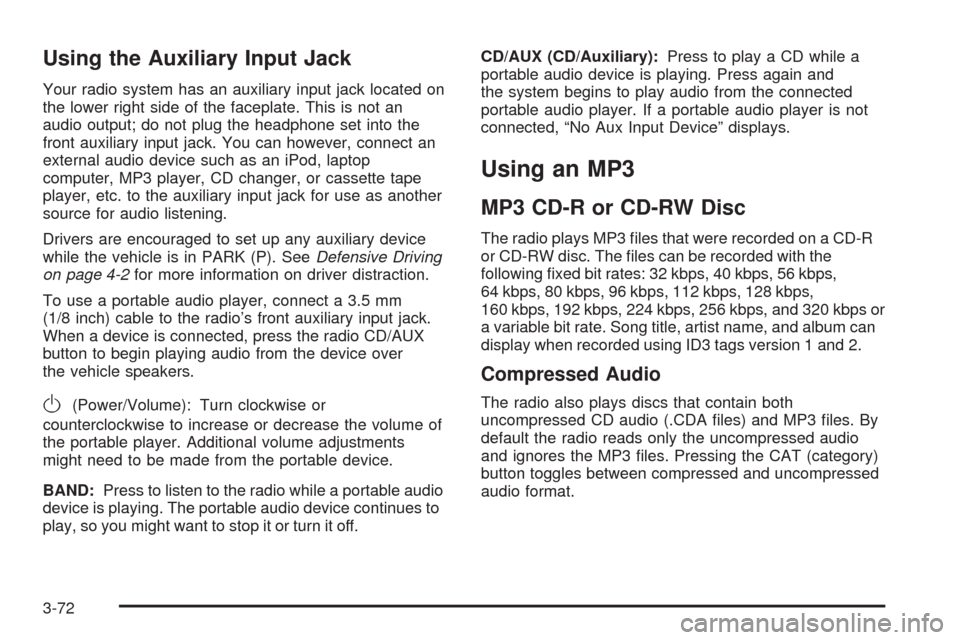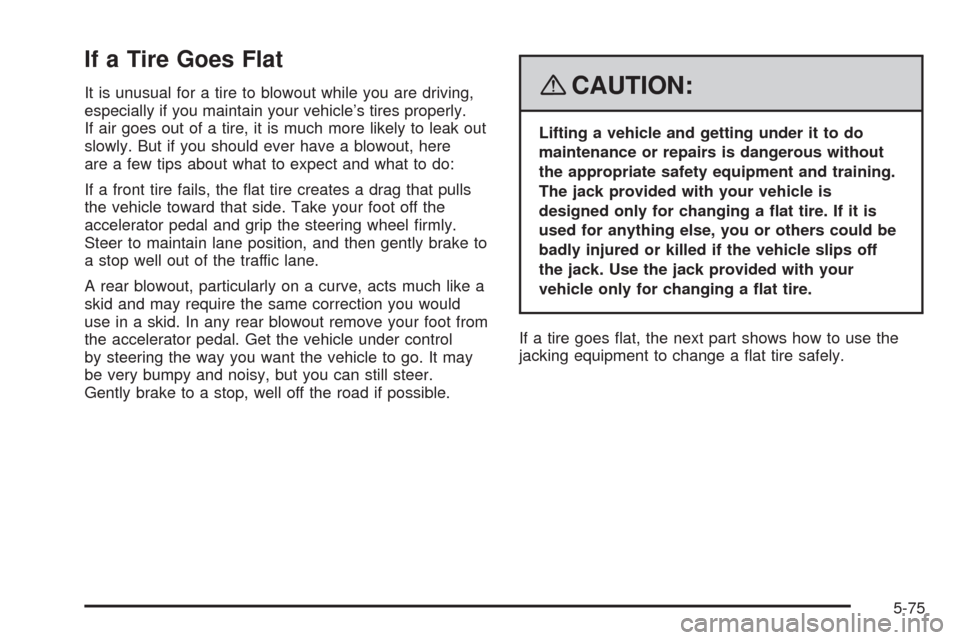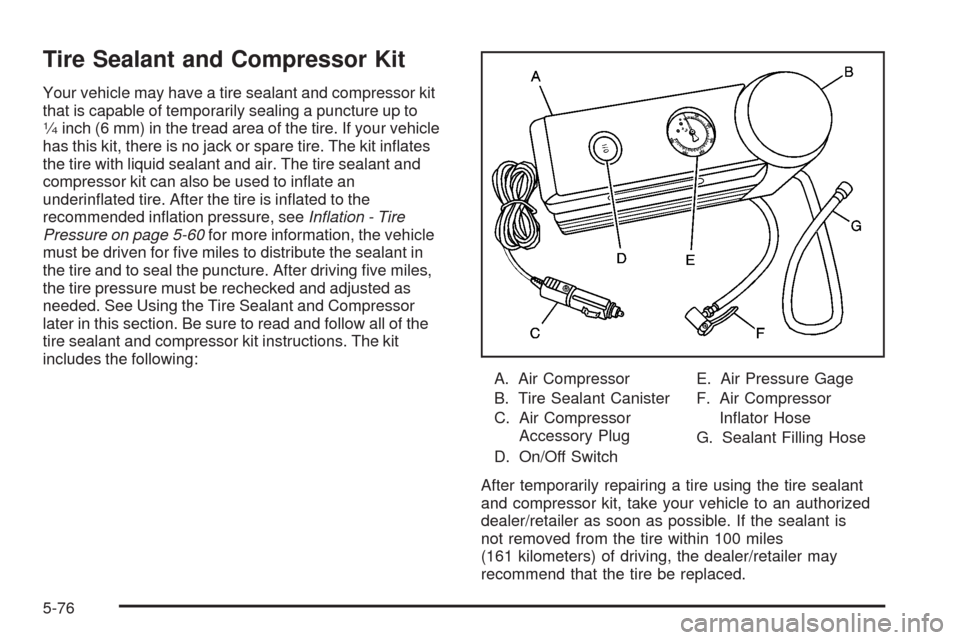Page 204 of 430

Using the Auxiliary Input Jack
Your radio system has an auxiliary input jack located on
the lower right side of the faceplate. This is not an
audio output; do not plug the headphone set into the
front auxiliary input jack. You can however, connect an
external audio device such as an iPod, laptop
computer, MP3 player, CD changer, or cassette tape
player, etc. to the auxiliary input jack for use as another
source for audio listening.
Drivers are encouraged to set up any auxiliary device
while the vehicle is in PARK (P). SeeDefensive Driving
on page 4-2for more information on driver distraction.
To use a portable audio player, connect a 3.5 mm
(1/8 inch) cable to the radio’s front auxiliary input jack.
When a device is connected, press the radio CD/AUX
button to begin playing audio from the device over
the vehicle speakers.
O(Power/Volume): Turn clockwise or
counterclockwise to increase or decrease the volume of
the portable player. Additional volume adjustments
might need to be made from the portable device.
BAND:Press to listen to the radio while a portable audio
device is playing. The portable audio device continues to
play, so you might want to stop it or turn it off.CD/AUX (CD/Auxiliary):Press to play a CD while a
portable audio device is playing. Press again and
the system begins to play audio from the connected
portable audio player. If a portable audio player is not
connected, “No Aux Input Device” displays.
Using an MP3
MP3 CD-R or CD-RW Disc
The radio plays MP3 �les that were recorded on a CD-R
or CD-RW disc. The �les can be recorded with the
following �xed bit rates: 32 kbps, 40 kbps, 56 kbps,
64 kbps, 80 kbps, 96 kbps, 112 kbps, 128 kbps,
160 kbps, 192 kbps, 224 kbps, 256 kbps, and 320 kbps or
a variable bit rate. Song title, artist name, and album can
display when recorded using ID3 tags version 1 and 2.
Compressed Audio
The radio also plays discs that contain both
uncompressed CD audio (.CDA �les) and MP3 �les. By
default the radio reads only the uncompressed audio
and ignores the MP3 �les. Pressing the CAT (category)
button toggles between compressed and uncompressed
audio format.
3-72
Page 329 of 430

If a Tire Goes Flat
It is unusual for a tire to blowout while you are driving,
especially if you maintain your vehicle’s tires properly.
If air goes out of a tire, it is much more likely to leak out
slowly. But if you should ever have a blowout, here
are a few tips about what to expect and what to do:
If a front tire fails, the �at tire creates a drag that pulls
the vehicle toward that side. Take your foot off the
accelerator pedal and grip the steering wheel �rmly.
Steer to maintain lane position, and then gently brake to
a stop well out of the traffic lane.
A rear blowout, particularly on a curve, acts much like a
skid and may require the same correction you would
use in a skid. In any rear blowout remove your foot from
the accelerator pedal. Get the vehicle under control
by steering the way you want the vehicle to go. It may
be very bumpy and noisy, but you can still steer.
Gently brake to a stop, well off the road if possible.{CAUTION:
Lifting a vehicle and getting under it to do
maintenance or repairs is dangerous without
the appropriate safety equipment and training.
The jack provided with your vehicle is
designed only for changing a �at tire. If it is
used for anything else, you or others could be
badly injured or killed if the vehicle slips off
the jack. Use the jack provided with your
vehicle only for changing a �at tire.
If a tire goes �at, the next part shows how to use the
jacking equipment to change a �at tire safely.
5-75
Page 330 of 430

Tire Sealant and Compressor Kit
Your vehicle may have a tire sealant and compressor kit
that is capable of temporarily sealing a puncture up to
1�4inch (6 mm) in the tread area of the tire. If your vehicle
has this kit, there is no jack or spare tire. The kit in�ates
the tire with liquid sealant and air. The tire sealant and
compressor kit can also be used to in�ate an
underin�ated tire. After the tire is in�ated to the
recommended in�ation pressure, seeInflation - Tire
Pressure on page 5-60for more information, the vehicle
must be driven for �ve miles to distribute the sealant in
the tire and to seal the puncture. After driving �ve miles,
the tire pressure must be rechecked and adjusted as
needed. See Using the Tire Sealant and Compressor
later in this section. Be sure to read and follow all of the
tire sealant and compressor kit instructions. The kit
includes the following:
A. Air Compressor
B. Tire Sealant Canister
C. Air Compressor
Accessory Plug
D. On/Off SwitchE. Air Pressure Gage
F. Air Compressor
In�ator Hose
G. Sealant Filling Hose
After temporarily repairing a tire using the tire sealant
and compressor kit, take your vehicle to an authorized
dealer/retailer as soon as possible. If the sealant is
not removed from the tire within 100 miles
(161 kilometers) of driving, the dealer/retailer may
recommend that the tire be replaced.
5-76
Page 340 of 430
Changing a Flat Tire (Vehicles with
spare tire)
If a tire goes �at, avoid further tire and wheel damage by
driving slowly to a level place. Turn on your hazard
warning �ashers.
{CAUTION:
Changing a tire can be dangerous. The vehicle
can slip off the jack and roll over or fall on you
or other people. You and they could be badly
injured or even killed. Find a level place to
change your tire. To help prevent the vehicle
from moving:
1. Set the parking brake �rmly.
2. Put an automatic transmission shift lever in
PARK (P), or shift a manual transmission to
FIRST (1) or REVERSE (R).
CAUTION: (Continued)
CAUTION: (Continued)
3. Turn off the engine and do not restart
while the vehicle is raised.
4. Do not allow passengers to remain in the
vehicle.
To be even more certain the vehicle will not
move, you should put blocks at the front and
rear of the tire farthest away from the one
being changed. That would be the tire on the
other side, at the opposite end of the vehicle.
5-86
Page 341 of 430
When you have a �at tire, use the following example as
a guide to assist you in the placement of wheel blocks.
The following information will tell you how to use the
jack and change a tire.Removing the Spare Tire and Tools
If your vehicle is equipped with a spare tire, the jack,
wheel wrench, and spare tire are stowed in the rear of
the vehicle, underneath the �oor of the cargo area.
To remove the spare tire and tools:
1. Open the liftgate. SeeLiftgate on page 2-12for
more information.
2. Remove the cargo cover.
5-87
Page 342 of 430
3. Turn the retainer counterclockwise to remove the
tire cover.
4. Remove the tire cover.
5. Remove the spare tire by placing your hands at the
four and eight o’clock positions. Gently pull it up
and out of the trunk. SeeCompact Spare Tire
on page 5-109.
6. Remove the wing nut that holds the jack. Then
remove the jack, wheel wrench, and �at tire strap.The tools needed are the jack (A) and wheel wrench (B).
5-88
Page 343 of 430
Turn the plastic wheel nut counterclockwise to loosen
the wheel wrench from the jack.Press the button and then pull on the end of the wheel
wrench to extend the handle.
5-89
Page 345 of 430
3. Position the jack on the rear position and raise the
jack lift head to �t over the car �ange under the
down arrow markings on the rocker panel.
{CAUTION:
Getting under a vehicle when it is jacked up
is dangerous. If the vehicle slips off the jack,
you could be badly injured or killed. Never get
under a vehicle when it is supported only by
a jack.
5-91